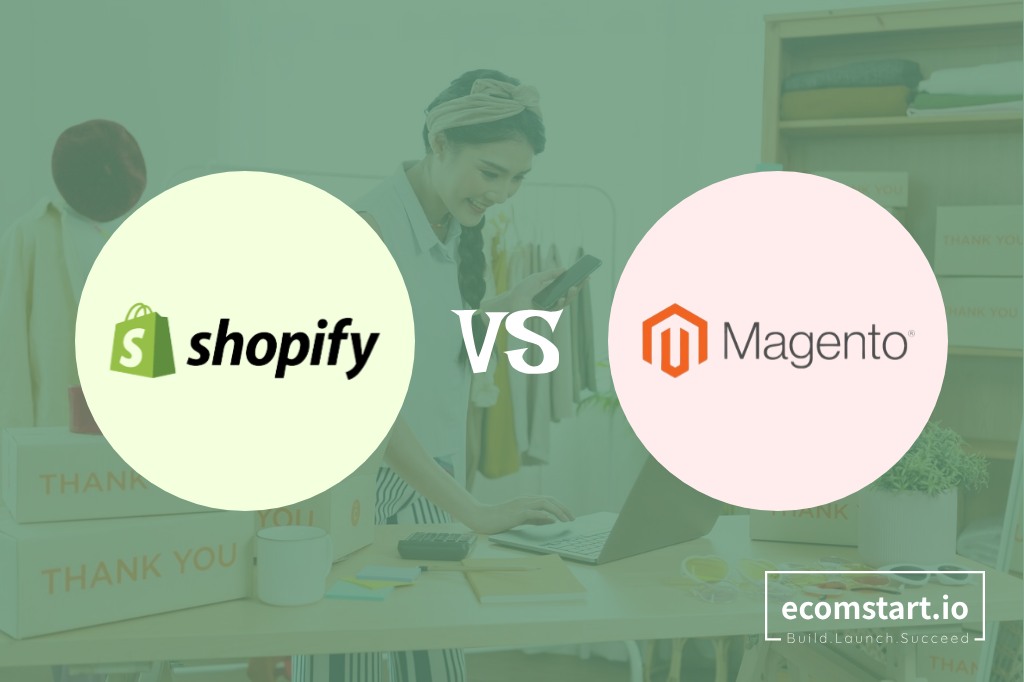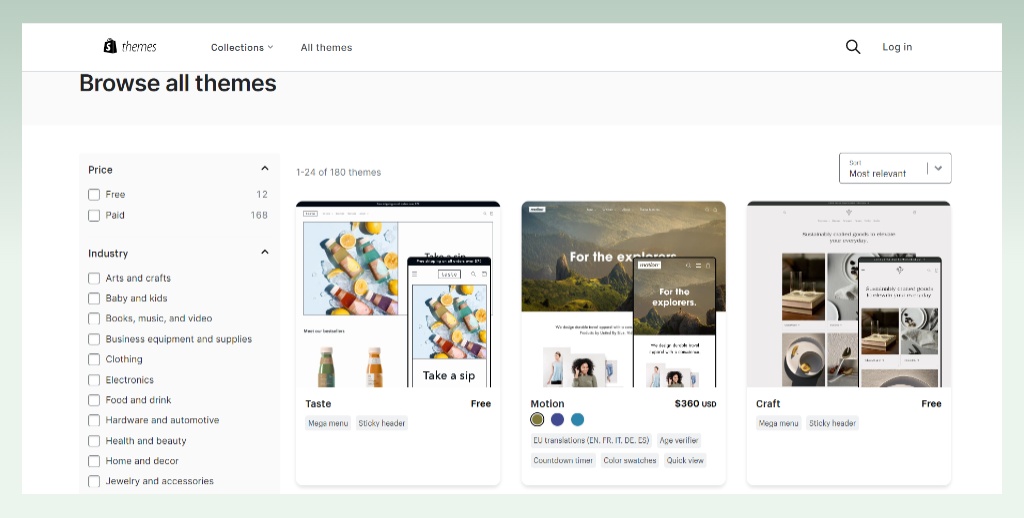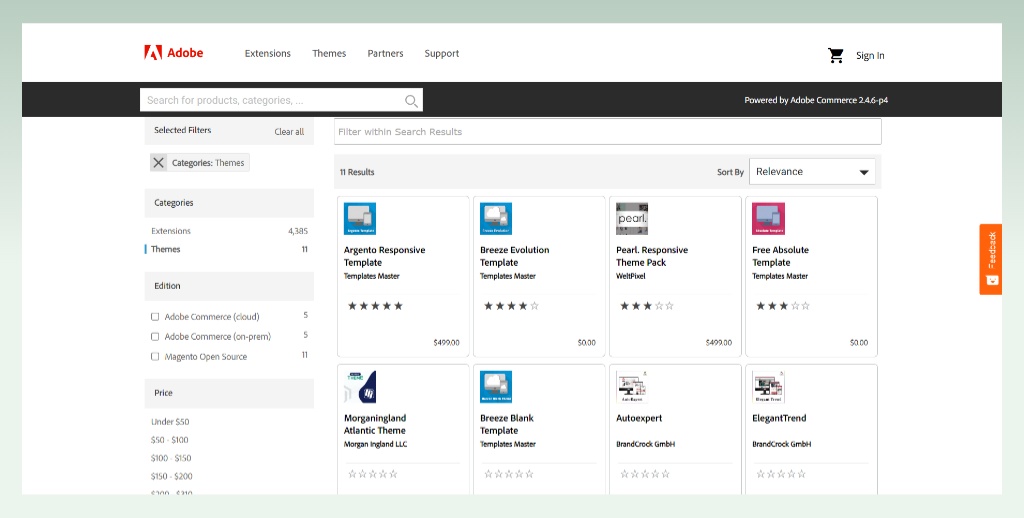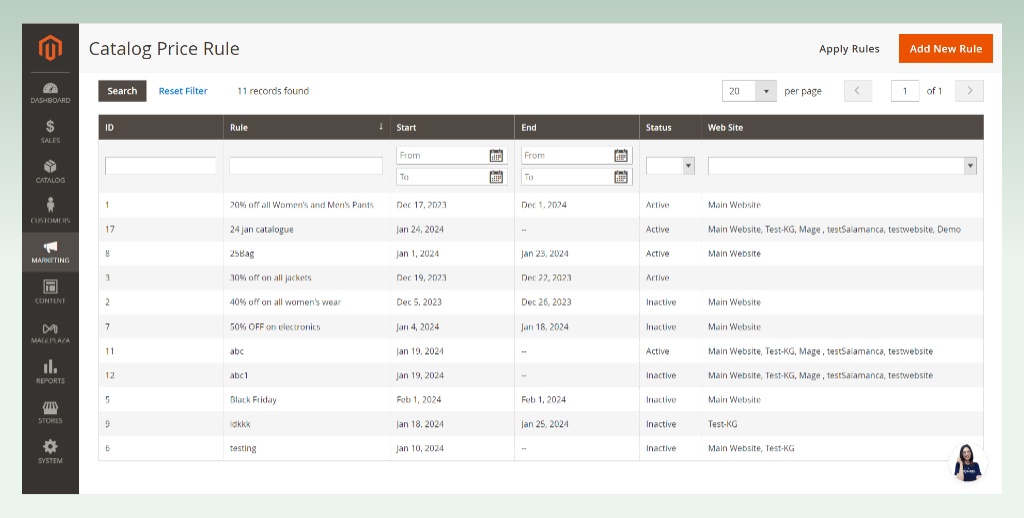Shopify vs Magento: Which is the #1 eCommerce Platform?

Are you weighing the pros and cons of Shopify vs Magento to decide on which one to use for your eCommerce store? Don’t worry; we’ve got you covered. In today’s article, we will compare Shopify and Magento side by side under 7 key factors. This spans pricing, customization, eCommerce features, scalability, etc.
Hopefully, after reading our comparison, you can pick a platform that fits your demand and budget best.
1. Key differences at a glance: Shopify vs Magento
 |  | |
| Definition | Shopify is a hosted eCommerce platform. You pay Shopify a monthly licensing fee to host your site, which includes all you need to launch a secured, functional e-store. | Magento is an open-source eCommerce platform. Magento is free to download and install, but you have to take care of hosting, domain, and an SSL certificate on your own. |
| eComStart’s overall rating | 4.8 | 4.2 |
| Pricing (We’ll cover a more detailed cost breakdown of both platforms below so don’t worry!) | Shopify is much more affordable than Magento. The platform offers 5 transparent pricing plans as below: 1. Shopify Lite: $9/month (no eCommerce website) 2. Basic Shopify: $39/month 3. Shopify: $105 4. Advanced Shopify: $399 5. Shopify Plus: from $2,500/month | Though Magento is free to install and download, you’ll have to pay several costs. To name a few: – Hosting: $100–500/year – Domain name: $10-$400/year – SSL certificate: $50 – $300/year – Design & development: $1,800 – $15,000/year Overall, expect to pay at least $1,000/month for a functional Magento store. |
| Target audience | Dropshippers and businesses of all sizes (largely small to medium ones). | Medium-to-large-sized businesses or enterprises. |
| Design and customization | Shopify themes are more diverse than Magento (12 free & 168 paid). | Magento’s themes are behind Shopify in number. However, as long as you’re comfortable with coding, Magento offers you fantastic designs and customizations. |
| Ease of use | Shopify wins convincingly. You can easily set up a functional web store using Shopify’s drag-and-drop editor and an intuitive dashboard. | Magento’s interface is clean. Nevertheless, the platform still requires a steep learning curve. Not to mention that the initial setup is super daunting. |
| eCommerce features | Shopify has an ecosystem of eCommerce features that work like a dream together. Regarding this aspect, we’re more impressed with Shopify than Magento. | Magento has an awesome set of advanced built-in eCommerce features. However, it still relies a bit heavily on third-party plug-ins. |
| Marketing tools | It’s a tie. Shopify has lots of built-in marketing tools. However, if you want to extend your store’s functionalities, you’d need marketing apps. | Likewise, Magento has powerful native marketing features. However, for more advanced features, you’ll also need to install plugins. |
| App integrations | Shopify beats Magento in terms of integrations. The Shopify App Store has over 8,000 apps spanning all functions– sales, marketing, localization, etc. | Magento Extension Marketplace has over 4,300 extensions. This number is impressive; however, it’s still not close to the number Shopify has. |
| Scalability | For the three basic pricing plans, Shopify can be a bit limited as your store grows. However, upgrading to Shopify Plus can solve the whole problem. | Magento is better regarding scalability. It can handle a large number of products and high volumes of traffic without compromising on performance. |
👀 Interested in launching your online store to success with Shopify? Sign up for a Shopify account today & enjoy using the platform at $1/month for the first month (no credit card required).
Shopify and Magento are both powerful eCommerce platforms. However, the biggest difference between Shopify and Magento is that as a hosted platform, Shopify is famous for its ease of use and robust built-in features.
Meanwhile, Magento’s strengths lie in the platform’s open-source nature, which allows you to build an online store exactly how you visualize it.
>>> Learn more: Shopify vs Clickfunnels: The Ultimate Comparison Guide
2. Shopify vs Magento: A deep dive comparison
Now that you have a better understanding of Magento 2 vs Shopify, let’s examine the two platforms under seven key factors.
2.1. Pricing
You won’t want to run your online store at a loss. Therefore, pricing is the first and foremost factor we’re going to discuss in this Shopify vs Magento comparison.
⚠️ Disclaimer: Pricing information in this blog is for the US and should be used for reference only.
2.1.1. Shopify
Estimated cost to own a functional Shopify store: From $5,000 a year.
As a hosted platform, Shopify charges you a monthly subscription fee to use the platform for your online business:
- Shopify Starter at $5/month (no online store): for businesses selling products largely through social media, email, SMS, WhatsApp, instead of managing an online store, Shopify Starter is the right choice.
- Basic Shopify at $39/month: for newbies who want to launch an online store with sufficient eCommerce, sales, and marketing features.
- Shopify at $105/month: for growing stores who want to extend your store’s functionalities with more advanced features, analytics, etc.
- Advanced Shopify at $399/month: for medium-to-large-sized stores who want to build a full-fledged online store with Shopify’s premium features like 10 times faster checkout capacity or 3rd-party calculated shipping rates, etc.

Besides the pricing plans above, Shopify also has an enterprise-grade package called Shopify Plus, which starts from $2,500/month.
However, if your store’s monthly transactions result in fees that are higher than $2,500, then instead of $2,500, you will be charged based on a percentage of that month’s transactions – which are:
- 0.25% for B2C transactions
- 0.18% for B2B transactions
For example: Suppose you make $2 million in revenue in February, and all your customers are B2C. Your transaction-based fee is 0.25% x $2 million = $5,000. And since $5,000 is higher than $2,500, your Shopify Plus’ fee in February is $5,000.
Let’s not forget about transaction fees. The higher the plan you choose, the lower Shopify’s payment processing fees get. Here’s a summary:
| Basic Shopify | Shopify | Advanced Shopify | Shopify Plus | |
| Online standard card rates | 2.9% + 30¢ | 2.7% + 30¢ | 2.5% + 30¢ | 2.15% + 30¢ |
| Third-party transaction fees for not using Shopify Payments | 2% | 1% | 0.6% | 0.2% |
From our experience, online standard card rates and in-person transaction fees of Shopify are acceptable.
However, if you are not living in countries where Shopify Payments are supported, prepare to pay extra transaction fees– which can be up to 2% if you’re on Basic Shopify.
Also, to extend your Shopify store, don’t forget to factor in app costs – which can vary from $50 to $5,000 per month.
2.1.2. Magento
Estimated cost to own a functional Magento store: From $12,000 a year
Magento has three versions– open-source, commerce, and commerce cloud. However, in the scope of today’s blog, we’ll talk about Magento’s open-source only. Well, since Magento’s open-source software is free to download, you won’t have to worry about licensing fees.
Nevertheless, the cost to operate a Magento web store can get pricey due to numerous other costs. From our experience, here are the most common costs and fees associated with launching a proper online store with Magento:
- Hosting: $100 – 500/year
- Domain name: $10 – 400/year
- SSL certificate: $50 – 300/year
- Initial setup: $500 – $1,000 per one-time
- Design and development: $1,500 – $15,000 per one-time
- Extensions: $60 – $600 per extension
- Payment processing fees: 2.9% + 30¢
- Marketing agency outsourcing fees: $10,000 to $40,000/year
Our verdict: Shopify wins with its affordable and transparent pricing plans. Both Shopify and Magento require extra costs to scale up your store efficiently (outsourcing, development, agencies, etc.)
However, on average, the cost to own a functional e-store is much cheaper with Shopify.
2.2. Design and customization
Next, let’s examine Shopify vs Magento in terms of design and customization options.
2.2.1. Shopify
The Shopify Theme Store has 12 free and 168 paid themes ($150 to $380) that are designed for stores of all niches and sizes. You can easily find any theme for your store, be it fashion, pet store, cosmetics, or electronics.

In terms of customization, you can leverage Shopify’s drag-and-drop theme editor to customize your store’s looks and feel effortlessly. For more advanced needs and wants, you can tweak Liquid code.
However, Shopify’s customizations do come with certain limitations as your store is hosted on Shopify’s server using Shopify’s language. For instance, one thing we don’t like is that Shopify’s checkout pages are not customizable (unless you’re on the Shopify Plus plan).
2.2.2. Magento
Unlike the Shopify Theme Store, Magento only gives you 11 theme options with 3 free and 8 paid versions (starting from $25 to $499). Clearly, this number is really limited when compared to the diverse options Shopify Theme Store offers.

However, when it comes to customization options, Magento gives you more flexibility over your store’s appearance. You can even localize your website for different customer segments or add any out-of-the-box features to your store.
Our verdict: It’s a tie. If you want diverse themes and peace of mind when customizing your store, Shopify is more than enough. However, if you need advanced customization over your visual storefront, Magento is more suitable.
2.3. Ease of use
You won’t want to spend hours after hours in front of the screen struggling with technical complexities while managing your store. Therefore, ease of use is the next factor we’ll examine in this Shopify vs Magento comparison.
2.3.1. Shopify
Shopify impresses us with its focus on user experience. Starting our journey with Shopify, the setup process felt streamlined and user-friendly. Choosing themes, adding products, and setting up payment options were straightforward tasks.
The dashboard is thoughtfully designed, making day-to-day operations smooth and manageable.
2.3.2. Magento
Magento, in contrast, requires a steeper learning curve. The initial setup process is much more complex than Shopify, so you will need to code or hire someone to do so.
Also, while Magento offers a comprehensive set of tools for managing your store, navigating Magento’s interface and using its full range of features requires more effort than Shopify.
Our verdict: Clearly, Shopify is the winner in terms of ease of use. It should be the go-to choice for those looking to quickly and efficiently set up and manage their online store.
2.4. eCommerce features
Let’s compare the eCommerce features of Shopify and Magento to see which one provides you with more sales tools to run and scale up your online store.
2.4.1. Shopify
As one of the best eCommerce platforms, Shopify offers you dozens of out-of-the-box eCommerce features. This includes:
- Abandoned cart recovery: You can automatically send emails to customers who didn’t complete their purchase on your site to win them back.
- Multi-channel selling: You can sync products from your Shopify Catalog to Amazon, Facebook, Pinterest, and Instagram to expand your sales channels.
- Selling digital products: With Shopify, you can sell digital items like ebooks or music, besides tangible products.
- Shipping partnerships: Shopify Shipping partners with big shipping companies like USPS, DHL Express, UPS, Canada Post, etc., giving you competitive shipping rates and the ability to fulfill your orders in 1 place.

2.4.2. Magento
Magento is also awesome when it comes to eCommerce features as well. Here are the highlight sales tools that Magento offers:
- Multi-channel selling options: Expand your store’s reach by using extensions to seamlessly integrate with platforms like Facebook, Instagram, and eBay
- Checkout customization: Enhance your customers’ shopping experience by designing a custom checkout process.
- Abandoned cart recovery: Re-engage customers who have left items in their cart without completing a purchase.
- Discounts and promotions: Easily set up and apply both percentage-based and fixed-price discounts to your products.
Our verdict: From our view, Shopify has better built-in eCommerce features. While Magento is great as well, the platform requires a lot of extensions– which may incur additional costs.
2.5. Marketing tools
No matter how good your products are, you need to promote your store effectively to drive traffic and sales. And for that, let’s continue our Magento eCommerce vs Shopify comparison regarding built-in marketing features.
2.5.1. Shopify
Shopify simplifies marketing for store owners by providing a suite of built-in features designed to help you promote your products effectively:
- SEO tools: Optimize your store for search engines with customizable titles, meta tags, and URLs. Shopify also automatically generates sitemaps, making it easier for search engines to crawl your site.
- Free automation app: Shopify has a free automation app called Shopify Flow, which empowers you to build custom workflow and automate your day-to-day operation tasks.
- Email marketing: Shopify Email allows you to create, execute, and track email marketing campaigns directly from your Shopify admin, using customizable templates and your customer data.
- Social media integration: Easily link your store to your social media accounts, enabling you to promote and advertise your products on social with ease.
- Discounts and coupons: Create discount codes and promotions that can be applied at checkout to help drive sales and customer loyalty.

2.5.2. Magento
Magento offers a robust set of marketing tools designed for customization and scalability, catering to businesses with more complex marketing needs:
- Advanced SEO capabilities: Besides the features Shopify offers, Magento also gives you ‘pro’ SEO features like Robots.txt file management, canonical meta tags to avoid duplicates, or Hreflang tags for localization, etc.
- Customer segmentation and personalization: You can target different customer groups with specific promotions and content based on their behavior, demographics, and purchase history.
- Rewards and loyalty program: This is one of the marketing features we love the most about Magento. This free, built-in feature allows you to build loyalty programs with points, rewards, and incentives that can be customized to your business model.
- Email marketing integration: While native email functionalities require extensions, Magento’s architecture supports deep integration with leading email marketing platforms.
- Promotions and pricing rules: Create complex promotional rules and pricing strategies that can be applied to specific products, categories, or customer segments.
- Content staging and preview: Schedule and preview changes to your promotions, product listings, and content, allowing for meticulous planning and execution of your marketing strategy.

Our verdict: It’s really a tie. We love Shopify for its seamless integration with social media platforms, allowing you to advertise your products effectively. Meanwhile, Magento is fantastic with its personalization features and great built-in reward system, letting you run loyalty campaigns without extensions.
2.6. App integrations
Shopify and Magento both provide you with tons of eCommerce and marketing features. However, to grow and tailor your store to your needs, you’ll need the help of third-party apps and extensions. This makes app integrations a key factor we’ll compare between Shopify vs Magento.
2.6.1. Shopify
The Shopify App Store has over 8,000 apps that span all kinds of features you’re looking for– from sourcing products, sales, marketing to analytics, etc.
2.6.2. Magento
Magento Extension Store accommodates over 4,300 extensions. Compared to most platforms, Magento is at the tip of the top. However, this number is still far behind Shopify.
Our verdict: It’s obvious that Shopify wins convincingly, with its number of apps doubling that of Magento.
2.7. Scalability
And last but not least, it’s important to choose a platform that can grow with your store. So, let’s see which one between Shopify vs Magento is a more scalable eCommerce platform.
2.7.1. Shopify
Shopify is one of the most scalable eCommerce platforms. Shopify allows you to sync your products to any channel you want. Plus, you can also localize your store for different markets with multi-language and multi-currency features.
For high-volume merchants, Shopify Plus offers enterprise-grade solutions, including higher levels of customization, dedicated support, and advanced features designed to handle the complexities of scaling large online stores
2.7.2. Magento
Magento is a powerful open-source platform known for its flexibility and control, offering significant scalability for businesses ready to invest in their growth.
With Magento, you have complete control over your hosting environment, allowing for customization and optimization at every level to handle increased traffic and transactions.
The platform’s modular architecture means you can extend and customize virtually every aspect of your store to meet specific business needs as you grow.
Not to mention that Magento also excels in creating a global presence, offering robust multi-language and multi-currency support and the ability to manage multiple stores from one backend.
Our verdict: Magento deserves the crown of the most scalable eCommerce platform as the platform can handle thousands of traffic and orders at the same time.
💡 Pro tips: Setting up an online store on Magento is more complex compared to Shopify due to the difference between open source and hosted platforms. Magento is ideal for those skilled in coding. Therefore, if you lack coding expertise and aim for a professional store with scalability in mind, consider Magento eCommerce development services from BSS. Their dedicated developers can help you build and scale a Magento store tailored to your needs.
3. Shopify vs Magento: Who holds the winning hands?
 |  | |
| Pros | ✔️ Easy to use ✔️ Transparent and affordable pricing plans ✔️ Fantastic built-in eCommerce and marketing features ✔️ Shopify has more diverse themes and third-party apps | ✔️ A highly scalable platform for growing stores ✔️ The design options are fantastic as long as you know how to code ✔️ Magento doesn’t charge you extra transaction fees like Shopify |
| Cons | ❌ There are still limits as to what you can customize. ❌ Shopify charges additional transaction fees if you choose not to use Shopify Payments. | ❌ It’s pricey to launch and manage an online store with Magento ❌ Magento isn’t suitable for non-techies |
| Suitable for | Businesses of all sizes looking for an easy-to-use, affordable platform with a robust set of eCommerce features. | Medium-to-large-sized businesses or ‘big fish’ that wish to launch a scalable, high-performing eCommerce store |
Looking beyond Shopify? Dive into “Shopify vs other eCommerce platforms” comparisons for a comprehensive perspective. Explore a wider range of options and discover the perfect platform to elevate your online store’s success.
4. Conclusion
Bravo for making it to this very line. After reading eComStart’s head-to-head comparison between two top-tier eCommerce platforms of all time, have you decided which one to choose yet between Shopify vs Magento?
If you are into eCommerce platform comparison blogs like this one, explore our honest, in-depth eCommerce comparison topics.
And remember to check out eComStart.io to get yourself updated with all things eCommerce.


